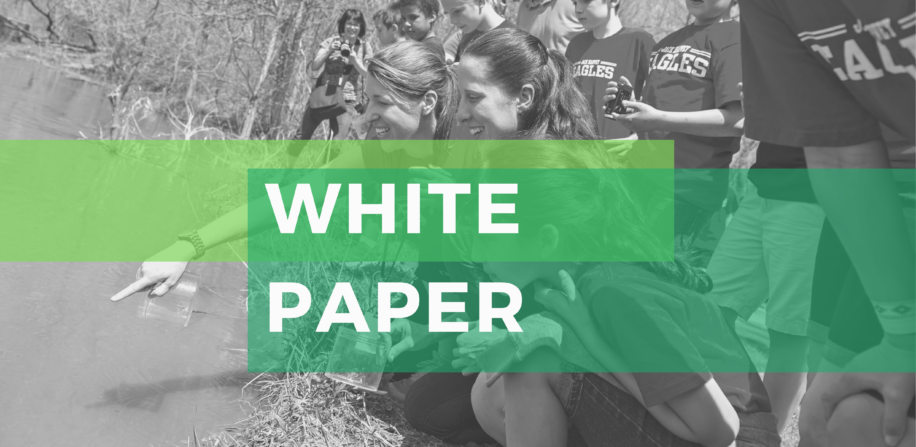VIDEO 3: An introduction to QTurn’s new measures developed to promote more accurate, feasible and low cost evidence about impact and equity in child development settings.
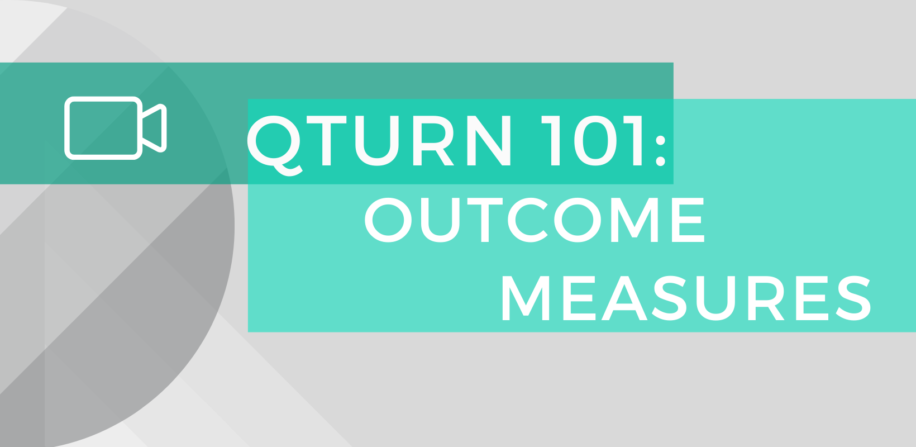


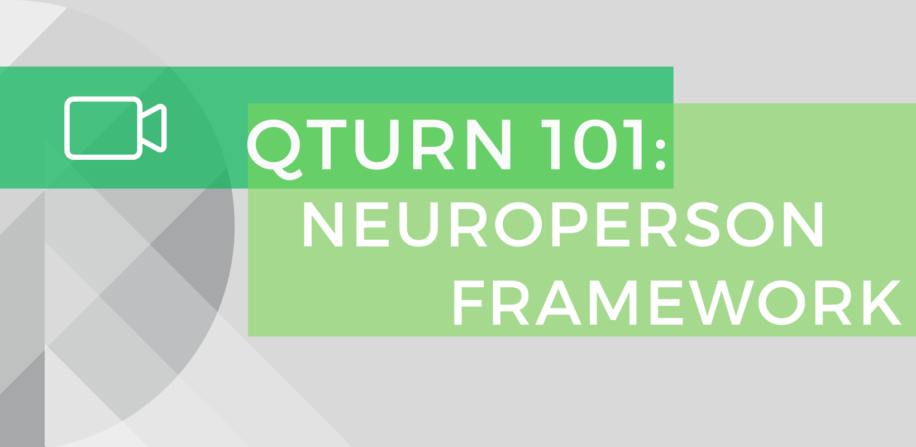

In the prior two blogs, we talked about how a group of master afterschool teachers at 25 afterschool sites in Genesee County have responded to the pandemic years. One important area of evolution was the new service models that put staff in the field visiting homes and meeting parents at drop off sites, producing a wide variety of online activity content, taking activities outside and, for the first time, implementing a whole new regime of personally protective equipment (PPE) and cohorting practices. This was a lot of new stuff!
The other area of innovation was in the practices that were delivered inside of afterschool programs during the return to in-person schooling for the 2021-2022 and 2022-2023 school years. This was a finding from the 2021-2022 end-of-year evaluation reports for YouthQuest:
Finding 3. YouthQuest has a compelling afterschool impact story about mental health prevention…in most cases staff teams achieved a “very-low or no-error rate” – there were no moments of missed opportunity. Every challenge was noticed by adults and almost all were addressed in the moment…. Every comment from a child merited an authentic response from an adult, and every adult continuously set and reinforced high expectations for socio-emotional skills. (See the report for YouthQuest.)
There was a similar finding in the Bridges end-of-year report. And we’re not kidding about every instance: In our data, intentional co-regulatory events were happening at a rate of 10 per hour per staff person. The master afterschool teachers at these sites were standing up their best practices and skills to respond to an increasing proportion of stressed children.
One of the key insights of the trauma-informed movement is to not mistake “misbehavior” (i.e., children not participating in the desired way) for children’s intentions. Children and youth who cannot keep their bodies in the activity space, who are frequently very worried about others, who simply can’t focus are likely enacting unconscious behavioral scripts that come from earlier ages and more stressful circumstances.
This means that, when children have been triggered in some way, they are projecting past-relevant emotions onto the current moment, and they are also acting out the behavior scripts that went with those past emotions. It is not because they want to or choose to. They don’t think about it. Its automatic.
We also use the term attachment-aware, which means being aware of the attachment skills that children bring into afterschool settings. Adult and youth attachment skills are what make up relationships between parent and child or teacher and child. In afterschool settings, the teacher brings the warmth and intent to care skills, and the child brings their prior experience at relationships with their own primary caregivers. It’s tough for an adult who is unknown to the child to effectively jump in to “have relationship,” or what we would call “co-regulate,” with children who are in the middle of acting out an energized script from an earlier time. It requires trust to help children change the focus of their awareness in that moment. Being “attachment aware” makes it possible to do the trauma-informed work of co-regulation with a “very-low or no-error rate.”
The formula is this: Adults are able to help children interfere with cycles of reactivity to the extent that a trusting relationship is achieved between the child and adult. In the next several sections, we tell four stories: Two about building children’s attachment skills and two about how teachers use their relationships to help students interfere with reactivity and integrate uncomfortable thoughts and feelings.
One best practice that we observed across networks was staff who were prepared to completely change expectations for the activity depending on where the children were at emotionally. The priority was to reach a calm and respectful connection between the adult and each student. A great example was Keke, one of the most “Zen” youth workers I’ve ever observed, working with a group of eight 4th and 5th grade students to get started on an activity about storytelling. What’s important is Keke’s decision that attunement had to come first.
When, after 15 minutes of trying to get started, Keke realized that for perhaps half of the children there was simply no way to settle down and start the activity. It was time to go to the floor mat and get a little bit more physical with a game of hot potato spelling words. This kept things in the general area of literacy but lowered the task demands – storytelling was too hard in that moment.
This process was a struggle too, but it allowed children to interact with a warm adult and be able to fidget and laugh (sitting on the floor together in a circle) while that adult was warmly but unflinchingly asking each child what’s going on for them and asking the rest of the children to respectfully witness the statements and feelings of the child speaking.
This process took about 40 minutes and, by the end, several emotionally energized topics had been discussed (e.g., having enough money to buy bracelets at school, why not to physically attack someone who has mocked you, using hand sanitizer to feel safe from COVID germs while passing the hot potato, how to comply with any of several community agreements). Perhaps most importantly, one student who rarely pays compliments paid a compliment to another and the group, and all thought this was significant.
Everyone was more settled and feeling more connected by the end of hot potato spelling words. The storytelling never happened, a few spelling words were spelled, but most of the eight children had the warm experience of being the focus of an adult who genuinely wanted to know what they were thinking and feeling in that moment.
Attunement is the process of an adult and child sharing eye contact and the adult reading the child’s emotional state and either mirroring what we call the broaden and build skill state or responding to a narrow and constrain skill state. In either case, attunement requires proximity to children who are willing to attune. At Brandon Nuby’s Holmes STEM Academy, collecting children operates as the state of the art – and uses an incentive/rewards system as the foundation of the practice.
To set the stage: Mr. Nuby had a group of perhaps 20 middle school aged newcomers to his program in fall 2022, particularly a large group of 7th grade boys. When I observed this group in fall 2022, the program had some moderate chaos, what some would call a tough group. However, because Mr. Nuby understands these 7th graders as little replicas of his own child self, he responds calmly with constant love and structure.
Part of that structure is the YouthQuest Bucks program – a way of earning bucks that can be used to buy things in the YQ Bucks Store and during amazing field trips that are a core part of the YouthQuest model. As Mr. Nuby stated in our fall 2022 interview, “I’ve got these kids coming to the program with YouthQuest bucks – we’ve been at our attendance limit almost every day, and I’ve been working on them.”
The socio-emotional skill growth, from year to year, was in evidence to me: A youth basketball game in the gym required constant supervision and frequently devolved into argument in fall 2021; that same group of students was able to self-organize into a 10-minute basketball game with few disruptions in spring 2022; by fall 2022, that same basketball game lasted 25 minutes and did not require a single adult support.
While it’s true that behavioral reward systems are effective for issues of basic regulation, like coming to the program every day, these systems are not what makes the basketball games get successively more well organized. This is the point of telling Mr. Nuby’s story. Mr. Nuby gets the kids attention with the YQ bucks – but it’s the attunement conversation that accompanies the exchange of bucks that matters for more advanced socio-emotional skill building. With every buck comes a conversation with Mr. Nuby or a member of this team who is handing out the bucks. Often, the staff are walking around with a handful of bucks at entry, and at other times during the program, collecting children.
Every student gets bucks at entry for coming each day, and each transaction involves a look in the eyes and a conversation about their feelings and how the day can go – a moment of emotional attunement for every student. The students, for their part, want to be collected, and look forward to the ritual of earning the YQ bucks as you can tell from the quote below (a composite from two eighth grade and one sixth grade student)
Most like the bucks because they have a lot of them stacked up. It’s very reasonable in how much we get each day; if you act up, your pocket gets hit. It’s like a good idea to get students to act right cuz, at the end, they get to go to a store to buy stuff… actual things that you would buy from a store…. If you have been acting up, he’ll tell you he is disappointed that you are going to get your money taken… and then, if you pick up the trays, he says thank you and good job. I’ve still got money from prior years at youth quest.
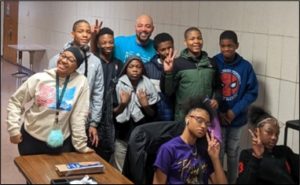
Mr. Brandon Nuby and Students at YQ Bucks Store, Brownell Elementary, Flint, Michigan
In the parenting literature, there are two terms that capture two important types of responsive adult behavior when parenting: synchrony and nurturance. Synchrony is when parents use encouragement to help children quickly generate positive emotions so they can return to the task, right in the moment (e.g., a child’s attention wanders, and an adult is there to bring it immediately back).
Nurturance is when parents use encouragement to help children downregulate negative emotion. When a parent decides that their child can’t keep going on the task, and child needs to stop for a check-in, it’s referred to as an adult’s act of nurturance. Nurturance, in this case, means making it 1-to-1 attunement for a moment and changing the child’s attention by modeling a broaden and build skill state and/or changing the circumstance in some way. These acts of co-regulation break the connection between the current circumstance (the trigger) and the child’s wandering attention, boredom, or overflowing emotion.
The 1-on-1 moment of nurturance was used most skillfully and intentionally in Fall 2022 at Brownell Elementary, where Miranda Manns has been site team leader the for the past 5 years. Miranda is a master afterschool teacher with extensive experience working in the positive youth development and trauma-informed approaches during her professional journey from parent volunteer to afterschool staff to program manager. When asked about the children who were struggling to manage their own bodies and emotions, the kids with their narrow and constrain skill engaged, Miranda replied:
We’re trying to get them to manage emotions and reminding them of things they had used in the past that worked when they were sad… and just always letting them know it’s okay to have negative feelings as well as negative attitudes but we have to manage them… something may have happened during the school day and they are still ruminating on it when they come in.
So, what happens at the intersection of stressed children in emotional overflow and staff who understand the attachment and trauma science? The first thing is completely consistent warmth and emotional containment from the staff. It didn’t matter if a single child was having a moment of meltdown, or if a group of children were having a moment of moderate chaos, the staff contained any reactivity they may have felt and continued to express high expectations with calm and caring body language and tone of voice.
The second thing that happened was lots of 1-on-1s where adults gave their mostly undivided attention to a child experiencing emotional reactivity and behavioral impulse. During our three-hour observation, nearly fifteen 1-on-1s were required by the five members of the staff team. Because our observation protocol included follow up questions, we know those 1-on-1s guided children toward mindfulness about their emotions because staff asked children what was happening for them in that moment, how they were feeling, and why.
Brownell also has a space for when the 1-on-1 needs a next step: the blue couch in the staff office. Miranda says:
“It’s almost like a healer or something, but once they sit on that couch… I’m not sure if its because I offered it or because they are actually able to get mindful and be at peace. The blue couch is the healer in this place, and I ask them if they need the famous blue couch or if they want to talk to Miss Manns about it.
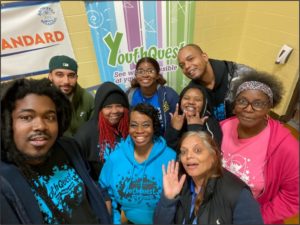
Miranda Manns and Staff at Brownell Elementary, Flint, Michigan.
As we saw with the 1-on-1s and blue couch at Brownell, staff were guiding children in distress toward mindful responses to their own overflowing or uncomfortable feelings and behaviors. Mindfulness is all about being aware of some specific things in the present moment. This also means not thinking about the past or future – which is what people in our society spend most of their time doing – and why it’s good to spend time building your present-focusing muscles.
Mindfulness interventions are suggested for children and adults with multiple ACEs because survivors are more likely to be triggered into narrow and constrain mental skill states (e.g., invasive thoughts, hypervigilance, avoiding people/places/topics, hyperarousal) that accompany the familiar behaviors of withdrawal, frustration, and disruption of self/others. Children’s capacity for openness, curiosity, and play are “hijacked” by an activated narrow and constrain skill state.
There are a few general mindfulness practices that are frequently recommended to manage narrow and constrain skill states in education settings. The first practice is focusing awareness for the purpose of building your present-focusing muscles by, for example, practicing mindfulness exercises as a group in afterschool programs. The second important mindfulness practice is learning how to focus on feelings and sensations inside of the body. This ability to focus on internal sensations is also called interoceptive awareness. These two mindfulness practices have lots of application in educational settings.
Danielle, at Pierce Elementary School, uses mindfulness practices weekly with students. Danielle’s explicit goal is to teach interoceptive skills that staff and children can use during the 1-on1 moments of nurturance, right after behavior has gone off track and the adult approaches. But the muscle building part is the preparation for use, and this happens with the whole group. When the interoceptive and other strategies are taught and practiced with all of the children, the tools become part of the culture and can be reinforced by peers as well.
Here is a snippet of what it sounds like when Danielle is doing the whole group mindfulness work at Pierce. In this case, children are spread out on the gym floor, and they have just listened to some very chill music and a guided meditation about how to become an observer of your own emotional states using the analogy of a feelings-fish swimming in your own brain-body pond:
This is subtle and powerful work. During the guided meditation, the children were quiet and guided to a mindful state by a story about a feelings-fish. The mindful state was a present-focused one, with students noticing their own feelings and seeing them as fish in their brain-body pond. This is direct practice at integrating charged emotional energy before it gets stronger – even before thinking about why I feel that way, I can try put myself in the position of observer rather than reactor. Another key point is that children don’t have to fully understand the process to get the benefits.
While practicing and building mindful muscles is a weekly part of program, its during the 1-on-1s that Danielle sees the tools and practice pay off. Specifically, when students have emotion/behavior challenges that fall outside of community agreements, students are given a 1-on-1 moment and a paper form that structures a process of “think and reflect” about “big emotions.” Daniel described an example of how it worked with one student this year, when…
… one day instead of following the same behavioral pattern of not regulating emotions, taking it out on others, throwing tantrums when upset, she began to self-regulate using the outline she had worked through so many times using the think sheets. This last time she became upset she asked to come to my office so that she could gather her thoughts to go have a constructive conversation with the other student… She then politely asked them for her things back and made it a point to ask the other student not to repeat the behavior, and instead, that if they asked nicely she would lend it to them.
The field of afterschool has evolved quickly since March 2020. Some new practices and possibilities developed in response to the pandemic yeras, from the pressing of resources at hand into the shape of urgent new needs. These new practices may spell out the future of afterschool services and the role of afterschool teachers in the post-pandemic period. As we noted in the first blog, the pandemic era saw the development of new service models that put afterschool teachers into new, externally-facing roles and relationships with children and families, depending on need.
But the innovation also happened on the inside. New practices from the attachment aware, trauma-informed perspective also came into more frequent and intentional use. While staff at most of the sites are now using many variations on these practices (e.g., heightened warmth, mindfulness techniques, proactive check-ins, tactile and safe space options, etc.), we in afterschool lack a common standard for responding to children with post-traumatic stress symptoms and/or developmental delays. These are practices that afterschool may want to add to quality standards, particularly during and after exposure to traumatic events and particularly for communities where exposure to traumatic events is more frequent or intensive (e.g., gun violence, climate disaster).

Like all managers I interviewed last fall, Keoshia, site manager for YouthQuest at Durant-Tuuri-Mott Elementary School, agreed that over 50% of this year’s students were behind academically. For that reason, the team at DTM Elementary afterschool is focused on math and literacy. However, for Keoshia and her team at DTM, the children’s socio-emotional skills are about the same as usual. This year was about picking up where last year left off in terms of socio-emotional skills – and then staying on those academics.
Indeed, when you step into the lunchroom with DTM’s 60 students and 7 staff, it’s hard to tell the difference from prior years. The kids look happy, they typically respond to the first request for quiet, and they reciprocate the parent-like warmth and care that DTM staff provide. This is a long-standing program with connections to families, a tight staff team (an average of 6 years of experience), and by the time of our October 2023 observation, already had a working program culture in place that was right where they wanted it.

Caption: Keoshia Cook with Durant-Tuuri-Mott Staff just Before dismissal.
Another program that, like DTM, received one of the highest quality scores this past fall was Mt. Morris High School, where site manager Zach T. sees the same pattern with their group of almost 30 adolescents. Everyone is struggling a bit on the academics, but their tight program culture produced a near two-hour roleplaying game that was the highlight of youth leadership in our fall round of data collection. For both of these programs, the story is that the pandemic was tough, but we made it through. The program culture is strong, and the young people and families keep coming back.
However, these two exemplary programs “picking up where we left off last year” were neither the exception nor the rule. Program cultures went in a very different direction at about 25% of the program sites we observed. Again, we’ve observed all of these sites for four years, and everything has been exemplary…. What was going on for these 25% of programs in fall 2022?
For the 25% of programs in fall 2022, a much higher percentage of children entered with severe developmental and academic delays. The general wisdom was that these were children whose parents withheld them from participation in school and afterschool during the prior year – in some cases having gone two, or in some cases three, years without participating in-person in an educational setting.
From the observations we completed in October and November 2023, two things were true for me as an observer: (a) There was a substantially increased proportion of children with socio-emotional and academic skill delays compared to prior years, and (b) for many of those struggling children, the socio-emotional and academic skill delays were more severe than I’ve ever seen in over two decades of observation.
Even with expert staff giving it their all, a couple of unsustainable things were happening: The setting was reaching moderate chaos numerous times during the session. Staff were constantly engaged in 1-on-1s with children struggling emotionally and behaviorally… and the other students, who were also struggling to keep it together, were more frequently joining the fray than they otherwise might have. Second, staff were spending a lot of energy in response to these repeated emotional and behavioral events. In our opinion, something had to change, or children were going to get seriously injured and/or really talented staff were going to quit.
This is an excerpt from a discussion memo that we, as a group, presented when agency staff at the state department of education asked what we were seeing in the field:
When student behaviors require immediate adult responses, that student is likely to be in what we refer to as a “narrow and constrain” mental skill state, a socio-emotional skill set that is largely non-conscious, endures through time, and severely limits mental and behavioral options for the child.
The pinch point for afterschool standards is that the appropriate response to these children requires one-on-one structure. Afterschool programs are not typically staffed to provide these 1-on-1 responses for more than 5% of children at any given moment. This fall (2022), the proportion of children in narrow and constrain skill states was as high as 40% at some sites. We estimate that anything over 10% is associated with light chaos, and anything over 20% brings moderate or greater chaos. Further, in the 20% or more condition, safety is difficult to assure beyond a ratio of 1 to 6.
Specific indicators of narrow and constrain skill states (i.e., low socio-emotional skill levels) were of four types:
Program directors were in a dilemma at the sites where higher proportions of children were presenting with severe socio-emotional skill delays. The “moments of moderate chaos” programs were either going to have to (a) exclude the kids who can’t self-regulate sufficiently, to assure safety for all students in the setting, or (b) relax attendance requirements and allow lower youth-to-adult ratios where necessary. In an example of evidence-driven and compassionate leadership by our state agency, requirements were relaxed with guidance to continue focusing on the most in need.
Enlighted leadership also came from sites. As annual improvement goals, site managers (independently of each other) chose nearly identical areas of focus: First, for children in narrow and constrain skill states, the focus was on helping those children learn and practice strategies that support “return” to a calm and open state of mind and body – what we call a “broaden and build” skill state. Not consequences, not exclusion, but strategies to be more emotionally resilient and mindful in moments of reactivity when strong emotions and behavior are flowing.
Second, and for the rest of the children, the goals were focused on helping “bystanders” intentionally exemplify and promote the program culture and norms (e.g., written community agreements, written program values). Both networks were planning more effort to communicate the desired program culture and values, i.e., the program’s purpose, what should be happening in the setting, and what the student’s role is.
Pre-pandemic, we could count on program cultures to replicate program norms year to year with returning students. Following the pandemic, these bets may be off for a few years.
This was the state of things in fall 2022. In mid-January, 2023, we asked all 25 site directors the following question: How are the narrow and constrain state kids doing? Are they quickly catching up on those socio-emotional skills for keeping bodies in place, maintaining focus, using our words etc.? Or is this going to be a long haul for this group, with the “catch up” or recovery phase lasting into subsequent years. To a person, all agreed that for many of these children it will be a multiple year effort. Several reported that things had not really changed much developmentally since late October for some children.
What does it mean? One thing that it means is that the converging stressors during the pandemic years – amped up “social determinants of health” for many families – have produced an interruption in socio-emotional skill development for a substantial enough group of children that we may need to do some things differently, at least for the next few years. Note that as a confirmation of traumatic events happening with children, we asked staff if they were worrying about child and family hardships. About 85% said yes to this indicator of vicarious trauma.
Another sign of interruption was the subject of technical assistance that emerged from entry interviews at the 25 sites during the fall 2022 round of observations. This is another excerpt from the memo for our state DOE:
Finally, as part of the feedback process to individual sites this year, we’ve addressed best practices for: Verbal bullies and victim self-confidence, addressing expressive language delays, addressing negative self-talk in the moment, mindful responsiveness in the moment, coldness is the opposite of warmth and has faster effects, swearing and sexual language, violent video games, how to do on-on-ones with a child in a narrow and constrain skill state, how to do a behavioral agreement with an individual student, etc.
These are not the same kinds of requests as in prior years – and reflect the reality of what afterschool teachers have to be able to engage with if they are to meet the goal of socio-emotional skill growth.

The field of afterschool program services has evolved quickly since March 2020, from the pressing of resources at hand into responses to urgent new needs. These new practices may spell out the future of afterschool services and new roles for afterschool teachers.
The new stuff can be broken into two chunks. First, there were new service models developed, new ways to support children and families, and these modes of service delivery could work in other times and circumstances. We’ll talk about three models below and how they could represent an evolution of the basic afterschool model – to include an external focus on connecting with children and families together, often inside of their own homes.
The second chunk of new work is in the definition of high-quality practice. While new service models were reaching out beyond the afterschool setting, a new definition of high-quality practices has taken shape in afterschool classrooms and clubs. The new definition of quality can be explained in terms of the familiar Maslow’s pyramid metaphor – the new stuff is all about improving supports at the bottom and top of the pyramid. In other fields, these additions are called “attachment-aware and trauma-informed.” These new practices are transforming our concepts about how adults work with children in the setting, particularly the increasing proportion of stressed children presenting signs of delay in both socio-emotional and academic skill domains.
The three blogs in this series will address this evolution of the afterschool service model in three parts: First, we’ll talk about the new externally-focused service models that emerged rapidly between March 2020 and end of summer 2022. In a second blog post, we’ll talk about the state of the children in fall 2023 and how afterschool practice is evolving to meet new needs that children are bringing to afterschool programs. In the final blog, we’ll outline some of the best practices that align with the “attachment-aware and trauma-informed” way of seeing high-quality settings.
That’s how I characterize the YouthQuest afterschool programs in fourteen Flint Community Schools and the ten Bridges to Success afterschool programs in seven different Genesee County school districts. Together, these 25 afterschool programs serve over 1,250 students each year and employ at least 150 staff. As the evaluator for these networks over the past four years, conducting evaluations and CQI cycles based on on-site observation and qualitative methods, we got up close and personal with every site. We were well positioned to describe how practices changed.
These schools also serve children that may have been affected by the lead-in-the-water crisis – so it has been the rare bit of really good news to know that top-flight developmental programming is available to many school-age children and adolescents in the city of Flint and its near suburbs. Pediatrician Mona Hanna-Attisha knew what to do for children who may have been exposed to lead. When Rachel Maddow asked: What should be done for children after the water pipes are fixed? The answer from Dr. Mona was: Give them top-flight cognitive-developmental programs (her example was Head Start). This is exactly what YouthQuest and Bridges to Success are delivering to school-age children in and around the City of Flint. This is no joke. Although contaminants like lead can damage the brain and change the performance of brain systems, powerful developmental experiences of the loving and engaging kind heal the brain and change the performance of brain systems in ways that compensate and transcend. And this logic applies to every other “insult” to children’s bodies and brains, i.e., ACE’s. This is the core assumption embedded in the idea of “attachment-aware, trauma-informed” practices.
The Flint region is a likely place to find professionals who know how to deliver very high-quality practice and be intentional about “positive youth development.” The city and region of Flint has a great 100 year history of community education and experiential learning – and, for the last 30 years, the Bridges and YouthQuest programs have been at the leading edge of positive youth development models for the children of Flint. Along with the Beacon’s programs in San Francisco and New York, these were networks where the positive youth development method was developed in practice in the late 1990s.
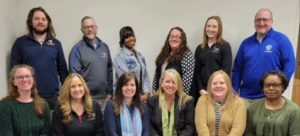
Aimee Phillips (bottom row, third from right), Program Director of the GISD Bridges to Success Programs, accompanied by the program site managers.

Willie Buford (center), associate program director of YouthQuest for Flint & Genesee Education & Talent LaQuanda Hammonds (right), Jimantra Grant (left), and Jeniffer Pocza (not pictured), site managers of YouthQuest for Flint & Genesee Education & Talent in Flint, Michigan.
As an evaluator and technical assistance provider who has now completed nearly 200 observations or professional development sessions with these 25 sites, I can report that there were maybe three cancellations, never a late meeting, and staff were always prepared. The average years of experience in teaching or afterschool across site managers was at least 12, and most worked in the same program for the past 5 years or more. These are both strong organizational cultures.
As to normative excellence: Twenty-two of 24 sites (98%) produced an instructional total score greater than 4.0 on the Youth and School Age PQA’s in the 2022-2023 school year. According to our science [Impact Evaluation for the Palm Beach County Quality Improvement System (QIS) using Fully Pattern-Centered Analytics – QTurn (qturngroup.com)), the programs scoring over 4.0 are producing equity effects in two ways: Children who enter with lower skills exit with more socio-emotional skill growth compared to their higher-skill peers; and children who enter with higher socio-emotional skills do not regress.
I can say. without hesitation, these two organizations are among the best run afterschool programs I’ve ever encountered. We’re writing these blogs because how these folks responded to the pandemic-years crisis is worth paying attention to. It tells us something about what is possible when families are experiencing crisis, and response is necessary.
The new service models emerged in three patterns: Crisis response, blended learning, and casework. These are described in greater detail in a report [In Review]. To summarize:
Personal Protective Equipment (PPE) was also a new practice in the pandemic years. We worked with these two networks to develop a set of indicators for use of personal protective equipment (PPE) inside the program. These are listed in Table 1. These PPE standards were applied during the 2021-2022 and 2022-2023 school years and are found here.
Table 1. Personally protective practices on the COVID 19 Setting Quality Assessment.
| COVID SQA | ||
| Personal Protections | Safe Environments | Screening Symptoms |
| Face masks | Sanitary Setting | Child and Teacher covid screening |
| Hand washing | Materials | Symptomatic student/teacher protocol |
| Social distance | Ventilation | Caregiver communication |
| Cohorts | Drinking water | |
| Meal setting | ||
| Pick-up/drop-off | ||
Because these PPE practices were implemented at high fidelity, we had some learnings: children in grades K-grade 8 were generally willing to wear masks, travelling in youth-adult cohorts through all aspects of the program improves relationships and community, and the online part of blended programming works well for some things (during a pandemic) like individual body movement, mindfulness, and including siblings and caregivers in programming.
In one sense, looking forward is about what the afterschool field might evolve toward. The new service models imply that afterschool programs can engage families in a different way that exceeds positive youth development experiences delivered inside of program settings. In general, these new afterschool models (that no doubt developed independently, and more or less successfully, all over the US and world during the pandemic years) open the possibility that afterschool programs could have family engagement functions, multi-generational models that might be much more effective for some children and families – and two-generation models have large effects. It may also be true that younger children are not automatically better off in a program after school is over – it may be that some kind of supported home-based service with their caregiver would be better for children under 3rd grade.
The other angle is climate response – we’re going to have more environmental catastrophes, and more refugees from environmental catastrophes, coming to our communities in the coming years. Program models that can check in with families quickly, deliver live or online positive youth development programs flexibly, and be able to help families in crisis seek basic services and keep their children connected to school will only be more important in the future.
In the next blog, we talk about the new needs that children were presenting with in fall of 2023…

With the publication of the IPCC report[1], it’s not difficult to conclude that our current political leadership is not going to take us where we need to go, and we can’t wait anymore. The scientists are telling us right now, in clear language, that the time is up: Major transformations in our thinking and behavior around energy use must happen right now. We’re already on track to exceed (by the early 2030s) the 1.5C degrees threshold of global warming (above pre-industrial levels), and the weather patterns that are projected to ensue, long before 2040, are going to be catastrophic for everyone on the planet. That’s the very difficult news. However, the amazingly lucky news is that there is still time to do something. So, what should that something be for OST professionals as OST professionals? What should we be asking our leading agencies and philanthropies to step in quickly and fund?
For the children, youth, families, and communitiesserved by OST programs, socio-emotional skills are at the top of my list, including getting up to speed on trauma-informed practices. We are likely to encounter more trauma from climate-related dislocation, intermittency of power, failing ground water systems, etc.
As important, how to protect children from talk about the ongoing climate catastrophe? How do we nurture their hopefulness rather than sharing our adult fear and unhealthy denial? How do we nurture our own hopefulness as an example? This is a profoundly important task if we are going to do anything at all as a field. The main point of this blog is that it’s our ethical obligation to the children and families that we serve to demonstrate hopefulness through our own OST practice, like setting examples in the time that we have rather than sticking our heads in the sand. It almost doesn’t matter how we go about addressing it as along as we communicate hope rather than fear while we’re doing it.
Another big one that we already know about is demographic change. We need to understand south-to-north migrations and how to be intentional about multiculturalism in practice and policy. This will be a place to use all of the equity stuff that so many of us have been working on and thinking about. We need to prepare for society with a bunch of folks from southern US states, Central America, Mexico, and the islands arriving in the next decade. Its already happening. Good news is that many of us are building our capacities to engage multi-cultural youth to embrace differences and learn about their own cultures (e.g., intersectionality) and to understand inequities.
There is a lot going on in our field in youth civic engagement. This is a small subset of our OST field, but these folks have been doing it for a long time, know how to do it, and have written a lot about it. The trick here is to re-focus what we know about how to do youth activism – e.g., community and service learning, voter registration and other issue-driven campaigns, peaceful protest – with the mental model that Greta (Thornburg) is providing about breaking carbon and consumption cycles.I can easily convince myself that learning how to break carbon and consumption cycles in everyday life is now more important than any time spent on academic testing for example (or advanced math or competitive sport etc. etc.).
One of the huge opportunities to demonstrate hope is precisely where we are least prepared: all of the new habits of daily life that we’re going to need to learn in a zero-carbon world. We are facing a task like the early twentieth century policy of agricultural extension that sought to educate a whole country of beginner-farmers about agricultural science and how not to starve in the countryside. But what institutions are filling this void?
Elsewhere we’ve referred to these habits as the applied science of ecological stewardship[2][SP1] – again, to push the agricultural extension analogy, think home economics for zero carbon. The new zero-carbon habits are all STEM skills even though the OST STEM field seems to be in denial. From my reading, these are the STEM issues that are directly and substantively related to reducing carbon use and living well in the future:
First, there is a lot to learn about energy use technologies and energy conservation skills. Dramatically reducing carbon use in the next three years and staying comfortable in everyday life is something we should all be learning about and about which there is almost certainly some content available for use in OST programs. This ranges from the simple stuff like when to best turn on and off the air conditioning to the basics of the new energy technologies and infrastructure that every neighborhood will need.
Another important set of STEM skills is related to food types and sources. It is an uncomfortable fact that two big ways to cut greenhouse gases and carbon use is to stop eating meat and to grow food locally. The arguments about the ecological implications of plant-based diets are clear and should at least be available to all persons. It’s also clear that growing your own local food in any city is likely going to occur on a brownfield where the underlying soil is already contaminated. This requires some horticultural design know-how and a little bit of soil science that many urban farmers are learning.
Another big one may surprise you: Almost all old trees (i.e., largest biomass retaining carbon) have been eliminated except for those in the urban forests maintained by our city and town governments and national parks. The carbon retaining potential of the urban forests is critical, and OST programs could learn a lot about trees (e.g., dendrology) and carbon retention from the several STEM disciplines involved. There are few afterschool programs actually located in non-urban areas (i.e., even in the countryside, OST programs are typically located in a small town). These cities and towns are home to the last remaining 60 year old+ trees in the United States and represent an important part of the solution for carbon retention.
Access to clean water is a major challenge of climate change, and procuring clean drinking water is going to involve all of the STEM disciplines – both building mental models for applied stewardship and then acting in those terms. Shouldn’t all OST students learn about the local clean water agenda and learn how to understand contaminants in water testing output? Shouldn’t all students learn about the science and technology involved with water filtration at home?
What about the power of the OST social movement – we professionals as a group? How could OST leaders help us act together as a coordinated profession to use our power? Are there a few obvious choices that we could ask leading agencies, membership organizations, and philanthropies to help us engage the field around?
The first question is: How do we quickly integrate all of this content into our professional conferences and workplaces so that we can quickly figure out how to help a next generation of ecological citizens, scientists, educators, advocates, and policy makers who are inheriting our legacy? A second question follows from the ethical charge to demonstrate hopefulness to children: How should we engage local administrators and governments on carbon-reducing practices for our buildings and program offerings? Finally: How do OST professionals engage in political activism as an interest-group to identify and advocate for breaking carbon and brownfield consumption cycles in personal lives and governance?
Although it may be uncomfortable to discuss these issues – the fear for all of us is real – it is our obligation to the children we serve to put them in the best position to deal with the situation, by building our own and their socio-emotional skills and mental models about the new zero-carbon world that’s coming. Please note also that all of the issues addressed above represent the major job categories of the future – for those still defining everything we do in terms of the economy. And finally, please also note that the OST profession is filled with rational people with progressive views. If we acted together, we could likely act as one. If we don’t act now, it will actually be too late. How can we organize ourselves and our young people and communities to amplify their voices, needs, and realities? How would we like our leaders at all levels to help?
[1] Intergovernmental Panel on Climate Change (IPCC; 2022), Climate Change 2022, Mitigation of Climate Change, Summary for Policy Makers [https://www.ipcc.ch/report/ar6/wg3/]
[2] Smith, C. (2019). SEMIS coalition for place-based ecological stewardship: Growing a movement, getting ready for growth. [https://www.qturngroup.com/wp-content/uploads/2022/04/2022-04-11_SEMIS_WP-v7.pdf]

Compassion has a lot of definitions, but most have to do with recognition of suffering, action to alleviate suffering, and tolerance of discomfort during the action.[i] By April of 2020, we knew that our afterschool partners in Genesee County (including the city of Flint) Michigan, and many of the children and families that they served, were suffering. A significantly higher proportion than usual of those families were in a crisis-mode. For afterschool educators, the learning environment had moved, and the means of delivering programs had changed dramatically. A “pivot” was required.
When our partners told us how evaluation could help, they emphasized a compassionate approach to the work that would address suffering in multiple ways: by reducing workload related to evaluation, by providing an evaluation design that was of timely value in the current moment of challenge, and by wherever possible reflecting back to staff their own incredible commitment and ingenuity in meeting those challenges.
We translated this desire for an experience of compassion into a few rules about method:
Rule 1 was make it quick. We knew that staff were in crisis mode and that time was precious. We eliminated all data collection responsibilities for staff. Staff had only to schedule dates for observers, sit for a 45-minute interview, review the report during a 70-minute training, and then review the report again during a subsequent 15 minute portion of an all-staff meeting. This meant less than 4-hours of total time for a site coordinator engaging in required evaluation activities between September and December 2021.
Rule 2 was prioritize local expertise. When program practices and objectives are changing rapidly (the pivot mentioned above), prior evaluation designs (including measures) are of reduced validity. This was true simply because it was no longer the same service – models varied widely both within and across programs.[ii] We asked open-ended questions about what was and wasn’t working and then coded text segments to existing program standards for program fidelity, instructional quality, and students’ socio-emotional skills. In this way, we identified standards that were applicable in the new situation, named new priorities in those terms, and respected site managers as expert sources of data about what works.
Rule 3 was ask about what is changing (and reflect strengths). Afterschool staff told us they felt like their professional tools became outdated overnight, by the pandemic, and it was not a good feeling. We spent our moments of access to leaders and site managers asking how it was going, letting them give voice to however it was going by taking the conversation wherever it went, and then by intentionally reflecting strengths back to them. Although this therapeutic aspect of our service may feel a bit uncomfortable to some evaluators, the situation required it as an aspect of method. As evaluators, we were “giving value to” leaders’ and site managers’ experiences by letting them flow some ideas and emotion while answering our questions.
Rule 4 was write it down. By asking staff about practices and coding their transcribed responses into categories, we were identifying sentences written by program staff that describe specific local best practices in specific local terms. By identifying and writing down local best practices in the words of program staff, the evaluator helps speed up the development of shared mental models about what the pivoted service is. This helps service providers demonstrate accountability in the sense of “this is actually what we did every day.” It also makes it possible for leaders to pivot the service more easily in the future by returning to documentation for crisis- or emergency-management.
[i] Strauss, C., Lever Taylor, B., Gu, J., Kuyken, W., Baer, R., Jones, F., & Cavanagh, K. (2016). What is compassion and how can we measure it? A review of definitions and measures. Clinical Psychology Review, 47, 15–27. https://doi-org.proxy.lib.umich.edu/10.1016/j.cpr.2016.05.004
[ii] Roy, L. & Smith, C. (2021). YouthQuest Interim Evaluation Report. [Grantee Evaluation Report]. QTurn. and Smith, C. & Roy, L. (2021). Best Practices for Afterschool Learning at a Distance: GISD Bridges to Success. [Grantee Evaluation Report]. QTurn.
